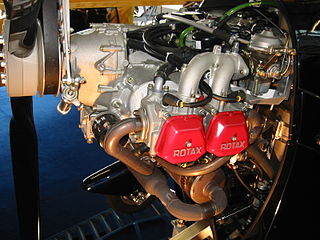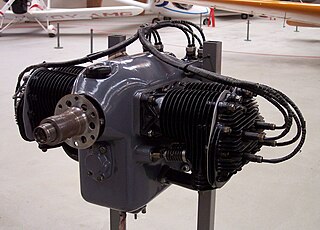Related Research Articles

The Rotax 914 is a turbo-charged, four-stroke, four-cylinder, horizontally opposed aircraft engine with air-cooled cylinders and water-cooled cylinder heads. It is designed and built by the Austrian company BRP-Powertrain, owned by Bombardier Recreational Products (BRP), as part of its Rotax brand.

The Continental A40 engine is a carbureted four-cylinder, horizontally opposed, air-cooled aircraft engine that was developed especially for use in light aircraft by Continental Motors. It was produced between 1931 and 1941.
The Rotax 532 is a 48 kW (64 hp) two-stroke, two-cylinder, rotary valve engine, liquid-cooled, gear reduction-drive engine that was formerly manufactured by BRP-Rotax GmbH & Co. KG. It was designed for use on ultralight aircraft.
The Rotax 618 is a 73.8 hp (55 kW) two-stroke, two-cylinder, liquid cooled, gear reduction-drive engine that was formerly manufactured by BRP-Rotax GmbH & Co. KG. It was designed for use on ultralight aircraft.
The Nelson Aircraft Corporation was founded in 1945 by sailplane pilot Ted Nelson and sailplane designer William Hawley Bowlus in San Fernando, California.

The Hirth F-33 is a single cylinder, two stroke, carburetted aircraft engine designed for use on ultralight aircraft, including powered paragliders and ultralight trikes. It is noted for its extremely light base weight of 35 lb (16 kg).

The Hirth 2702 and 2703 are a family of in-line twin cylinder, two stroke, carburetted aircraft engines designed for use on ultralight aircraft and especially two seat ultralight trainers, single seat gyrocopters, and small homebuilts.
The Hirth 2704 and 2706 are a family of in-line twin cylinder, two stroke, carburetted aircraft engines, with optional fuel injection, designed for use on ultralight aircraft and especially two seat ultralight trainers, single seat gyrocopters and small homebuilts.
The Hirth F-30 is a horizontally opposed four-cylinder, two-stroke, carburetted aircraft engine, with optional fuel injection, designed for use on ultralight aircraft and homebuilts.
The Hirth 3701 is an in-line three-cylinder, two-stroke, carburetted aircraft engine, with optional fuel injection, designed for use on ultralight aircraft and small homebuilts.
The Hirth F-36 is a single-cylinder, two-stroke, carburetted aircraft engine designed for use on ultralight aircraft, especially powered paragliders and ultralight trikes. It is noted for its extremely small equipped weight of 28 lb (13 kg) including exhaust system, reduction drive and carburetor.
The Hirth 3202 and 3203 are a family of in-line twin cylinder, two stroke, carburetted aircraft engines, with optional fuel injection, designed for use on ultralight aircraft, especially two seat ultralight trainers, gyrocopters and small homebuilts.
The Hirth 3502 and 3503 are a family of liquid-cooled, in-line twin-cylinder, two-stroke, carbureted aircraft engines, with optional fuel injection, designed for use on ultralight aircraft and small homebuilts.
The Zanzottera MZ 201 and MZ 202 are a family of twin-cylinder, in-line two-stroke, dual ignition aircraft engines designed for ultralight aircraft and motor gliders.
The KFM 112M is a four-cylinder, four-stroke, dual ignition, horizontally opposed aircraft engine designed for ultralight aircraft and motor gliders.
The 2si 540 and 2si 500 are a family of in-line twin-cylinder, liquid-cooled, two-stroke, dual ignition, aircraft engines that were designed for ultralight aircraft.
The 2si 690 is a family of in-line three cylinder, liquid-cooled, two-stroke, dual ignition, aircraft engines that were designed for ultralight aircraft.

The Bowlus/Nelson BB-1 Dragonfly is an American, two seat, strut-braced, high-wing motor glider that was developed from the Bowlus BA-100 Baby Albatross glider by Hawley Bowlus.
The Nelson H-63, known in the US military designation system as the YO-65, is an American dual ignition, four-cylinder, horizontally opposed, two-stroke aircraft engine that was developed by the Nelson Engine Company for use in helicopters and light aircraft. The engine designation means horizontally opposed 63 cubic inch displacement.
The Rotax 535 is an Austrian aircraft engine, that was designed and produced by Rotax of Gunskirchen for use in motor gliders.
References
- 1 2 3 4 5 6 7 Federal Aviation Administration (April 1947). "Aircraft Type Certificate Data Sheet GTC19" (PDF). Retrieved March 10, 2011.
- 1 2 Activate Media (2006). "Dragonfly Bowlus Nelson". Archived from the original on July 15, 2011. Retrieved March 10, 2011.
- 1 2 Said, Bob: 1983 Sailplane Directory, Soaring Magazine , page 118. Soaring Society of America, November 1983. USPS 499-920